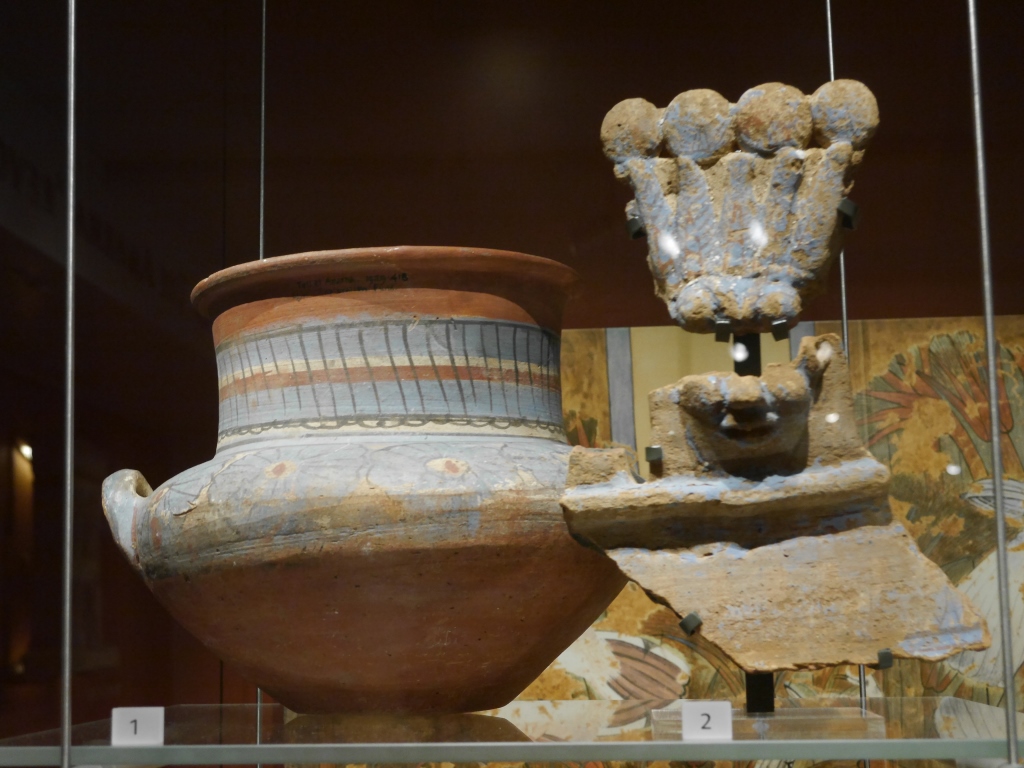You don’t have to go to Egypt to see spectacular artefacts from the 14th century BC reign of the pharaoh Akhenaten – if you’re in England you can go to the Ashmolean Museum in Oxford and see a beautiful display of material from Akhenaten’s capital at Tell el-Amarna, excavated by the British archaeologist Flinders Petrie and his successors from the late 19th century. The display is small and intimate and yet contains some of the most famous Akhenaten artefacts, including the fresco of the two princesses shown below and the relief carving of Nefertiti being touched by the Aten. While I was writing my novels Pharaoh and Pyramid I visited the exhibit several times to get that sense of immediacy with the past that’s so important to me, from seeing – and touching – artefacts from the period I’m writing about, and to ponder what it was that made the ‘Amarna’ period in Egypt so distinctive and appealing.
By ditching the old religion to focus on worship of the sun-god, the Aten, Akhenaten also dispensed with the complex iconography which can bedevil the appreciation of Egyptian art, and probably inhibited its development. Instead of having to remember the names of gods and symbols you can bask in the sensuality and humanity of the depictions of Akhenaten’s family, and the exuberance and impressionism of the marshland scenes of birds and plants. Although this too has a religious aspect – Akhenaten and his family were the sole mediators with the Aten, and the natural world provided the offerings that were made to the god – one of the fascinating aspects for me is the similarity of the paintings in particular with Aegean art of this period, produced in Greece and Crete. While this may represent a kind of artistic flowering across the East Mediterranean at this time, when increased trade and the movement of people and ideas could have spread a common artistic taste, it may also reflect political and dynastic ties – something I touch on in my novel Pyramid. At the Ashmolean you can judge this for yourself because one of the other great collections of the museum is the Aegean Bronze Age material brought back by Arthur Evans from his excavations at Knossos on Crete, now also superbly displayed following the refurbishment of the museum and its reopening in 2009.
The galleries below contains some photos from the Amarna exhibit I took during a recent visit. Click on the images to enlarge them. The first gallery shows some of the beautiful cobalt-blue pottery of the period, decorated with palm designs reminiscent of the wall paintings of Amarna and probably representing the flowered garlands that were draped around these vessels, most of them probably for wine. Although the cobalt colouring is not directly paralleled in Aegean art of this period the style and touch is reminiscent of Minoan and Mycenaean pottery painting. The fourth photo emphasizes this connection, showing two Egyptian ‘pilgrim flasks’ copying Aegean forms of this period. I’ve handled similar flasks from a shipwreck at Uluburn off Turkey which contained material from many different cultures that participated in the trade and diplomatic networks of this period, including a gold ring with the cartouche of Nefertiti.
The paintings below are from a plaster pavement showing wild geese taking flight from a marsh, a wall-painting depicting a shrike on a papyrus stem, and the so-called ‘Princesses Fresco’, a fragment of wall-painting showing two daughters of Akhenaten and Nefertiti seated with their parents, their images now lost. The fourth photo shows fragments of faience and glass ornaments, products of a thriving industry at el-Amarna used to decorate royal dwellings and private houses.
The final four images show a limestone window grille from a house at el-Amarna, a lintel from a doorway with the cartouches of Akhenaten and Nefertiti and those of the Aten, with traces of blue paint visible (as well as paint on the cornice above), and two small relief sculptures of Nefertiti, the first one a famous image showing an arm of the Aten extending to touch her – an image of intimacy in keeping with much else in Amarna art – and the second one clearly showing the sun-disk rays of the Aten.
With the reinstatement of the old religion after Akhenaten’s death the cartouches and images of the pharaoh were largely destroyed, meaning that most finds are damaged or defaced and have come from rubbish deposits at Amarna. The one image of the pharaoh in the Ashmolean exhibit is the headless sandstone sculpture beside Nefertiti in the centre of the room, showing the distinctive bodily shape characteristic of images of Akhenaten – whether the result of an actual physical condition or a representation of the androgynous nature of the Aten is impossible to tell. Akhenaten’s true appearance thus remains an enigma, but something more important about him is revealed in the other artefacts in the room – evidence of a cultural flowering in which Egyptian artists were briefly released from the shackles of the old religion, and showed that they were as capable of expression as free and pleasing as the art of the Aegean world at this period.













